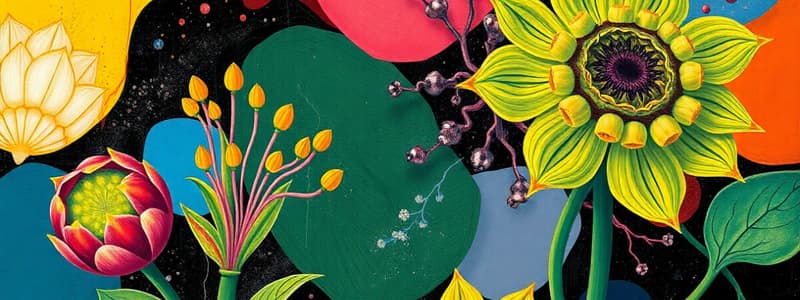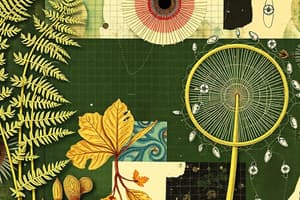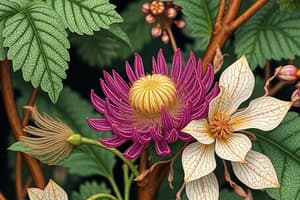Podcast
Questions and Answers
Which of the following is the primary function of flowers in angiosperms?
Which of the following is the primary function of flowers in angiosperms?
- To provide structural support for the plant.
- To store water and nutrients for the plant.
- To facilitate sexual reproduction by producing gametes. (correct)
- To conduct photosynthesis for energy production.
What is the primary role of fruit in flowering plants?
What is the primary role of fruit in flowering plants?
- To provide nutrients to the developing plant.
- To attract pollinators with bright colors and scents.
- To protect the seed and aid in its dispersal. (correct)
- To conduct photosynthesis for energy production.
Which of the following best describes asexual reproduction in plants?
Which of the following best describes asexual reproduction in plants?
- The process of seed dispersal by wind or animals.
- The production of genetically identical offspring from a single parent plant. (correct)
- The fusion of two gametes to produce offspring.
- The transfer of pollen from the anther to the stigma.
What is a key disadvantage of asexual reproduction in plants?
What is a key disadvantage of asexual reproduction in plants?
What percentage of land plants do angiosperms represent?
What percentage of land plants do angiosperms represent?
Which structure of the flower protects the flower bud as it develops?
Which structure of the flower protects the flower bud as it develops?
What is the collective term for all the petals of a flower?
What is the collective term for all the petals of a flower?
Which of the following structures is responsible for holding the anther?
Which of the following structures is responsible for holding the anther?
Which part of the carpel receives pollen?
Which part of the carpel receives pollen?
What distinguishes a 'complete' flower from an 'incomplete' flower?
What distinguishes a 'complete' flower from an 'incomplete' flower?
What is the key difference between 'perfect' and 'imperfect' flowers?
What is the key difference between 'perfect' and 'imperfect' flowers?
What is a primary characteristic of plants described as 'monoecious'?
What is a primary characteristic of plants described as 'monoecious'?
What process leads to the production of megaspores inside the megasporangium?
What process leads to the production of megaspores inside the megasporangium?
What is the fate of most megaspores after they are produced by meiosis?
What is the fate of most megaspores after they are produced by meiosis?
How many haploid nuclei are typically present in a mature female gametophyte before fertilization?
How many haploid nuclei are typically present in a mature female gametophyte before fertilization?
The anther of a flower typically consists of how many microsporangia?
The anther of a flower typically consists of how many microsporangia?
What is the immediate product of microsporocytes undergoing meiosis?
What is the immediate product of microsporocytes undergoing meiosis?
What is the function of the 'tube cell' within a pollen grain?
What is the function of the 'tube cell' within a pollen grain?
Why is water unnecessary for sexual reproduction in many plants?
Why is water unnecessary for sexual reproduction in many plants?
What is an advantage of animal-pollinated plants compared to wind-pollinated plants?
What is an advantage of animal-pollinated plants compared to wind-pollinated plants?
What is the difference between self-pollination and cross-pollination?
What is the difference between self-pollination and cross-pollination?
In angiosperms, approximately what percentage of pollination is achieved abiotically?
In angiosperms, approximately what percentage of pollination is achieved abiotically?
What flower characteristics are common in wind-pollinated plants?
What flower characteristics are common in wind-pollinated plants?
Which of the following pollinators are most attracted to flowers that exhibit short wavelengths such as ultraviolet?
Which of the following pollinators are most attracted to flowers that exhibit short wavelengths such as ultraviolet?
What is the primary attractant for moths to flowers?
What is the primary attractant for moths to flowers?
What is the primary role of the tube cell after a pollen grain lands on a stigma?
What is the primary role of the tube cell after a pollen grain lands on a stigma?
In double fertilization, what does the fusion of the second sperm cell with the polar nuclei result in?
In double fertilization, what does the fusion of the second sperm cell with the polar nuclei result in?
Which of the following represents the correct sequence of events during angiosperm double fertilization?
Which of the following represents the correct sequence of events during angiosperm double fertilization?
What is the origin of the seed coat?
What is the origin of the seed coat?
What is the role of the endosperm in seeds?
What is the role of the endosperm in seeds?
Which term describes the embryonic root of a seed?
Which term describes the embryonic root of a seed?
What is the primary function of fruit?
What is the primary function of fruit?
Why is seed dormancy important for plant survival?
Why is seed dormancy important for plant survival?
What does 'scarification' refer to in the context of seed germination?
What does 'scarification' refer to in the context of seed germination?
What environmental conditions are crucial for breaking dormancy in seeds?
What environmental conditions are crucial for breaking dormancy in seeds?
What is the term for germination in which cotyledons are brought above ground?
What is the term for germination in which cotyledons are brought above ground?
What determines positive geotropism in germinating seeds?
What determines positive geotropism in germinating seeds?
You discover a new plant species with imperfect flowers that only produce carpels. To successfully reproduce via cross-pollination, what specific environmental condition or agent MUST be present?
You discover a new plant species with imperfect flowers that only produce carpels. To successfully reproduce via cross-pollination, what specific environmental condition or agent MUST be present?
Which statement most accurately describes the evolutionary significance of double fertilization in angiosperms?
Which statement most accurately describes the evolutionary significance of double fertilization in angiosperms?
A botanist discovers that a species of plant has completely lost its ability to reproduce sexually, relying solely on rhizomes for propagation. Considering this evolutionary shift, what long-term disadvantage would MOST likely arise for this plant species compared to its sexually reproducing relatives?
A botanist discovers that a species of plant has completely lost its ability to reproduce sexually, relying solely on rhizomes for propagation. Considering this evolutionary shift, what long-term disadvantage would MOST likely arise for this plant species compared to its sexually reproducing relatives?
A plant species exhibits "pseudocopulation" as a means of pollination. Given what you know about plant reproduction, this means?
A plant species exhibits "pseudocopulation" as a means of pollination. Given what you know about plant reproduction, this means?
What is the direct product of meiosis in the megasporangium?
What is the direct product of meiosis in the megasporangium?
If a plant is described as dioecious, what does this indicate about its reproductive structures?
If a plant is described as dioecious, what does this indicate about its reproductive structures?
Which of the following is a key characteristic of an 'incomplete' flower?
Which of the following is a key characteristic of an 'incomplete' flower?
What is the role of the generative cell in a pollen grain?
What is the role of the generative cell in a pollen grain?
Which of the following floral traits is most likely to attract moth pollinators?
Which of the following floral traits is most likely to attract moth pollinators?
In angiosperms, what is the result of the fusion between the second sperm cell and the two polar nuclei during double fertilization?
In angiosperms, what is the result of the fusion between the second sperm cell and the two polar nuclei during double fertilization?
What is scarification in the context of seed germination, and why is it important?
What is scarification in the context of seed germination, and why is it important?
What evolutionary advantage is conferred to plants that utilize biotic pollination compared to those that rely on abiotic pollination?
What evolutionary advantage is conferred to plants that utilize biotic pollination compared to those that rely on abiotic pollination?
A researcher discovers a new angiosperm species in which the megasporocyte undergoes meiosis but the resulting megaspores fail to develop into a female gametophyte. Although pollen is produced normally, no fertilization occurs. What is the MOST likely consequence for the plant's reproduction?
A researcher discovers a new angiosperm species in which the megasporocyte undergoes meiosis but the resulting megaspores fail to develop into a female gametophyte. Although pollen is produced normally, no fertilization occurs. What is the MOST likely consequence for the plant's reproduction?
In a scenario where a plant species has evolved to rely solely on asexual reproduction via fragmentation, and sexual reproduction has been entirely lost, what long-term evolutionary disadvantage is MOST probable for this plant species compared to other sexually reproducing species?
In a scenario where a plant species has evolved to rely solely on asexual reproduction via fragmentation, and sexual reproduction has been entirely lost, what long-term evolutionary disadvantage is MOST probable for this plant species compared to other sexually reproducing species?
Flashcards
Flowers
Flowers
Sexual reproductive structures of angiosperms that produce gametes and promote fertilization.
Seed
Seed
The embryo and nutrients of a plant surrounded by a protective coat.
Fruit
Fruit
Surrounds and disperses seeds away from the parent plant.
Asexual Reproduction
Asexual Reproduction
Signup and view all the flashcards
Rhizomes
Rhizomes
Signup and view all the flashcards
Advantage of Asexual Reproduction
Advantage of Asexual Reproduction
Signup and view all the flashcards
Flower
Flower
Signup and view all the flashcards
Sepals
Sepals
Signup and view all the flashcards
Petals
Petals
Signup and view all the flashcards
Corolla
Corolla
Signup and view all the flashcards
Stamen
Stamen
Signup and view all the flashcards
Anthers
Anthers
Signup and view all the flashcards
Filament
Filament
Signup and view all the flashcards
Carpel
Carpel
Signup and view all the flashcards
Stigma
Stigma
Signup and view all the flashcards
Style
Style
Signup and view all the flashcards
Ovary
Ovary
Signup and view all the flashcards
complete Flower
complete Flower
Signup and view all the flashcards
Incomplete Flower
Incomplete Flower
Signup and view all the flashcards
Perfect Flower
Perfect Flower
Signup and view all the flashcards
Imperfect Flower
Imperfect Flower
Signup and view all the flashcards
Monoecious Plant
Monoecious Plant
Signup and view all the flashcards
Dioecious Plant
Dioecious Plant
Signup and view all the flashcards
Integuments
Integuments
Signup and view all the flashcards
Micropyle
Micropyle
Signup and view all the flashcards
Megasporocyte
Megasporocyte
Signup and view all the flashcards
Mature female gametophyte
Mature female gametophyte
Signup and view all the flashcards
Microsporangia
Microsporangia
Signup and view all the flashcards
Microsporocytes
Microsporocytes
Signup and view all the flashcards
Pollen grain
Pollen grain
Signup and view all the flashcards
Pollination
Pollination
Signup and view all the flashcards
Fertilization
Fertilization
Signup and view all the flashcards
Self-Pollination
Self-Pollination
Signup and view all the flashcards
Cross-Pollination
Cross-Pollination
Signup and view all the flashcards
Abiotic Pollination
Abiotic Pollination
Signup and view all the flashcards
Biotic Pollination
Biotic Pollination
Signup and view all the flashcards
Fertilization
Fertilization
Signup and view all the flashcards
Form Sperm
Form Sperm
Signup and view all the flashcards
Dormancy
Dormancy
Signup and view all the flashcards
Study Notes
- Reproduction and development are key to the success of flowering plants
Asexual and sexual reproduction
- Animal survival relies on herbivores/omnivores consuming plant reproductive structures.
- Includes flowers, seeds, and fruit
- Flowers are sexual reproductive structures of angiosperms that produce gametes, promote fertilization, and create fruit and seeds.
- Seeds consist of an embryo and nutrients protected by a seed coat.
- Fruit surrounds and disperses seeds.
- Angiosperms make up over 85% of land plants.
- Nearly every domesticated plant is an angiosperm
Asexual Reproduction
- Asexual reproduction results in offspring that are genetically identical to the parent plant.
- Rhizomes, horizontal underground stems, can produce a new plant.
- Asexual reproduction is efficient for spreading species.
- Asexually propagated plants can be susceptible to epidemics caused by disease or pests.
Heterosporous Alternation
- Microsporangium contains a microsporocyte (2n) that goes through meiosis to create a microspore (n)
- The microspore becomes a male gametophyte (n) that produces sperm (n) in antheridia
- Megasporangium contains a megasporocyte (2n) that goes through meiosis to create a megaspore (n)
- The megaspore becomes a female gametophyte (n) that produces eggs (n) in archegonia
- Eggs are fertilized and creates a zygote (2n) which becomes a sporophyte (2n)
Flower Structure
- A flower has highly modified leaves and four components from outside in.
- Sepals are thick, leaflike structures to protect the flower bud as it grows.
- Petals are brightly colored and scented to attract pollinators.
- Corolla: an entire group of petals.
- Stamen: male reproductive structure
- Anthers create pollen
- Filament holds anthers
- Carpel: female reproductive structure
- Stigma receives pollen
- Style is a slender stalk
- Ovary contains ovules
Flower Variations
- Complete flowers have all four parts.
- Incomplete flowers are missing a part.
- Perfect flowers have both stamens and carpels.
- Imperfect flowers have only stamens.
- Monoecious plants have both male and female reproductive structures.
- Dioecious plants have either stamens or carpels.
Female Gametophytes
- An ovary contains one or more ovules with integuments.
- There is one opening called the micropyle.
- Ovules contain a megasporangium, inside of which is a diploid megasporocyte.
- A megasporocyte divides by meiosis to produce four haploid megaspores.
- Three of the four megaspores degenerate.
- The surviving megaspore divides by mitosis three times to produce eight haploid nuclei.
- A mature female gametophyte has eight nuclei arranged inside an embryo sac.
- An egg resides directly behind the micropyle opening.
- Two polar nuclei are located in the large cell in the center of the ovule.
Male Gametophytes
- The anther has four microsporangia.
- Microsporocytes divide by meiosis to produce haploid microspores.
- Each microspore develops into a pollen grain (male gametophyte).
- A generative cell produces two sperm.
- A tube cell directs growth of the pollen tube.
Pollination
- Pollination: transfer of pollen grains from an anther to a stigma.
- Fertilization: egg unites with sperm, making a zygote.
- Water is unnecessary for sexual reproduction, allowing plants to colonize drier environments.
- Wind-pollinated plants use a lot of energy to make pollen.
- Animal-pollinated plants use less pollen but use energy to "pay" pollinators.
Pollination types
- Self-pollination: pollen from anther of an individual is transferred to the stigma of the same individual.
- Cross-pollination: pollen from one individual is carried to another individual.
Abiotic Pollination
- Abiotic Pollination uses wind for ~10% of angiosperms
- Flowers aren't showy
- Uses light weight pollen
- Has a stigma with a large surface area
Biotic Pollination
- Biotic pollination uses animals for ~90% of angiosperms
- Animals are attracted by flowers
- Sugary nectar is made for some pollinators
- Extra pollen is used as food for other pollinators
- Uses scent
Animal Pollinators
- Honeybees, 80% of all pollination, come to flowers for pollen.
- Flowers use short wavelengths; best with blue, purple, and violets
- Butterflies use perfume-y nectar, and are attracted to light scent.
- Moths are out at night, and use large white/cream flowers with heavy scent, for flowers and nectar.
- Flies are attracted to a carrion flower, use look and smell.
- pseudocopulation attracts wasps looking for a mate in orchids.
- Hummingbirds see long wavelengths, red and orange, but have a poor sense of smell.
- Bats prefer large flowers or flower clusters that are identifiable by echolocation and musky smell.
- Hummingbirds and long tubular flowers, hawkmoth species and Darwin's orchid, and pronuba moth and yucca, create pollinators.
Fertilization
- Pollen grain reaches the stigma.
- The tube cell grows a pollen tube down the style, down to the micropyle of the ovule.
- A generative cell divides to form two sperm.
Double Fertilization
- First sperm unites with egg, making a zygote (2n).
- Second sperm unites with two polar nuclei, forming the endosperm (3n).
- Endosperm cells are loaded with starch, oils, proteins, and nutrients.
Seed Components
- Embryo sporophyte: from 2n zygote.
- Endosperm: (food supply) from 3n cell resulting from fusion of 2nd sperm and 2 polar nuclei.
- Seed coat: from integuments (ovule).
Embryo Sporophyte
- Parts of the embryo sporophyte
- Cotyledons: seed leaves
- Hypocotyl: seed stem
- Radicle: embryonic root
- epicotyl: embryonic leaves
Fruit
- Fruit: ripened ovary.
- An ovule matures to form the seed, ovary ripens to form fruit.
- Functions protect the seed(s), delay germination, disperses seed.
- Seed dispersal can be via wind, water, or animals.
Seed Dormancy
- Seed dormancy allows survival through harsh conditions.
- Scarification, disruption of the seed coat so water can enter, may be necessary.
- This is done through fire, passage through animal's digestive tract, and abrasion by wind- or water-driven soil particles
- Seeds go through environmental conditions
- Requires correct temperature, water, and oxygen availability
Germination energy
- Energy for germination can come from endosperm.
- In other seeds, cotyledons break down and absorb endosperm before the seed becomes quiescent.
- The seed has large cotyledons but no endosperm.
- Germination needs a rapid influx of water.
- The seed swells and breaks open, allowing the embryo to emerge
- Geotropism: response to gravity; tips of roots and stems control roots
- Roots emerge that have positive geotropism.
- Shoots emerge that have negative geotropism.
Types of Germination
- Epigean: cotyledons brought above ground
- Hypogean: cotyledons stay below ground
Studying That Suits You
Use AI to generate personalized quizzes and flashcards to suit your learning preferences.




